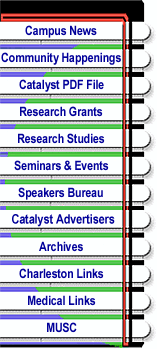
Return to Main Menu
|
Learn facts about trans fats, find
alternate cooking methods
by
Charlotte Crotte
Dietetic
intern
The state of New York has banned them, many fast food establishments
are researching ways to replace them, and as of Jan. 1, 2006, the
Federal Drug Administration mandated that the American public be
made aware of their presence on all packaged food labels. You have
probably heard rumors about these bad guys, but it is time to learn
some facts about trans fats.
The 2005 Dietary Guidelines for Americans suggest keeping trans fat
consumption as low as possible. Research has proven that consuming too
many trans fats (as well as saturated fat and dietary cholesterol) can
raise bad cholesterol (LDL) levels. Elevated LDL levels increase the
risk of coronary heart disease and, considering it is one of the
leading causes of death in the United States, this is something that
should concern people. But many Americans wonder, “What exactly are
trans fats and what can I do to avoid them?”
Unlike other forms of fat, trans fats are not required by the human
body. They can have detrimental effects on cardiovascular health. Trans
fats are created when hydrogen is added to vegetable oil resulting in
hydrogenated or partially hydrogenated oil. The result is a trans fatty
acid that is more stable than most fats and therefore is added to many
foods to increase their shelf life. Trans fats are also found naturally
in some meats and dairy products, but the majority of trans fats
consumed do not come from these sources.
The majority of trans fats in the American diet come from processed
foods. Trans fats can be found in shortenings, margarine, cookies,
crackers, snack foods, fried foods, baked goods, and almost any other
processed food you can imagine. Many restaurants use partially
hydrogenated oils when they cook, bake, and fry their food. Thankfully,
some restaurants and food producers are heeding the warnings of the
dangers of trans fats and are looking into alternative cooking oil
options such as monounsaturated and polyunsaturated fats. Be sure to
check all nutrition labels and avoid products that have the words
“partially hydrogenated” included in the ingredients. Most foods that
contain trans fats can be made with a non-hydrogenated oil substitute
and many food producers are doing an excellent job of making this clear
on their packaging.
It is important to note that although trans fats are making most of the
headlines, it is still important to limit your intake of saturated
fats. It is recommended that less than 10 percent of your total daily
calories come from saturated fats, because they can also raise your
cholesterol and increase the risk of heart disease. Unfortunately it
happens all too often that trans fats are replaced with saturated fats.
Always check nutrition labels to make sure you are limiting the amount
trans fat and saturated fat and adding more non-hydrogenated fats and
oils to a balanced diet.
Best options for monounsaturated and poly-unsaturated include olive,
canola and peanut oils; olives, avocados; cashews, almonds, peanuts;
soybean, safflower, sunflower, and cottonseed oils; and fish and
seafood.
Friday, Feb. 23, 2007
Catalyst Online is published weekly,
updated
as needed and improved from time to time by the MUSC Office of Public
Relations
for the faculty, employees and students of the Medical University of
South
Carolina. Catalyst Online editor, Kim Draughn, can be reached at
792-4107
or by email, catalyst@musc.edu. Editorial copy can be submitted to
Catalyst
Online and to The Catalyst in print by fax, 792-6723, or by email to
catalyst@musc.edu. To place an ad in The Catalyst hardcopy, call Island
Publications at 849-1778, ext. 201.
|


